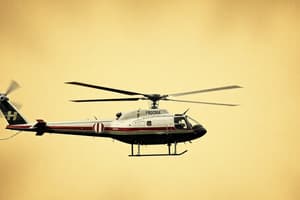Podcast
Questions and Answers
Which position on the rotor disk has the highest velocity of airflow during forward flight?
Which position on the rotor disk has the highest velocity of airflow during forward flight?
- 3 o’clock position (correct)
- 9 o’clock position
- 1 o’clock position
- 6 o’clock position
During forward flight, the airflow direction is the same as the helicopter's flightpath.
During forward flight, the airflow direction is the same as the helicopter's flightpath.
False (B)
What happens to the advancing blade as its relative wind speed increases?
What happens to the advancing blade as its relative wind speed increases?
The advancing blade gains lift and begins to flap up.
The retreating blade reaches its maximum downflap velocity at the ______ position.
The retreating blade reaches its maximum downflap velocity at the ______ position.
Match the terms related to helicopter blade dynamics with their definitions:
Match the terms related to helicopter blade dynamics with their definitions:
What is the main contributing factor to the dissymmetry of lift in helicopters?
What is the main contributing factor to the dissymmetry of lift in helicopters?
Translating tendency refers to the upward movement of a helicopter during hovering flight.
Translating tendency refers to the upward movement of a helicopter during hovering flight.
What happens to the relative wind speed acting on the retreating blade as the helicopter moves forward?
What happens to the relative wind speed acting on the retreating blade as the helicopter moves forward?
Dissymmetry of lift can cause a helicopter to be ________ in any situation other than hovering in calm wind.
Dissymmetry of lift can cause a helicopter to be ________ in any situation other than hovering in calm wind.
Match the following helicopter concepts with their descriptions:
Match the following helicopter concepts with their descriptions:
Flashcards are hidden until you start studying
Study Notes
Airflow in Forward Flight
- In forward flight, airflow occurs opposite the direction of the aircraft's flightpath.
- The velocity of airflow across a rotor blade depends on the blade's position, rotational velocity, and helicopter airspeed.
- Airflow velocity is highest on the advancing blade (3 o'clock position) and lowest on the retreating blade (9 o'clock position).
Advancing Blade
- As the relative wind speed increases on the advancing blade, lift increases, causing the blade to flap upwards
- This upflap creates downward airflow, which reduces the angle of attack (AOA) of the blade.
Retreating Blade
- As the relative wind speed decreases on the retreating blade, lift decreases, causing the blade to flap downwards.
- This downflap creates upward airflow, which increases the angle of attack (AOA) of the blade.
Dissymmetry of Lift
- Dissymmetry of lift refers to the unequal lift produced by the advancing and retreating halves of the rotor disk due to different wind speeds.
- This difference in lift would make the helicopter uncontrollable without a mechanism to compensate.
Translating Tendency (Drift)
- During hovering flight, a single main rotor helicopter tends to move in the direction of the tail rotor thrust.
- This lateral movement is referred to as translating tendency.
Pendular Action
- Pendular action refers to the swinging motion of the helicopter fuselage, side to side or back and forth.
- This motion is caused by changes in lift or thrust.
Coning
- The rotation of the rotor disk creates centrifugal force, which pushes the blades outward from the main rotor hub.
- The faster the rotation, the greater the centrifugal force.
Coriolis Effect
- The Coriolis effect, also known as the law of conservation of angular momentum, states that the angular momentum of a rotating body remains constant unless an external force is applied.
- This means a rotating body will maintain its rotational velocity until an external force changes it.
Gyroscopic Precession
- Gyroscopic precession occurs when a force is applied to a spinning object, causing a deflection 90 degrees later in the direction of rotation.
- This principle applies to the helicopter main rotor, acting like a gyroscope.
Autorotation
- Autorotation is a state of flight where the main rotor disk is turned by the flow of air moving upwards, rather than engine power.
- This is made possible by a freewheeling unit, a clutch mechanism that allows the rotor to turn freely if the engine fails.
- Autorotation is essential for safe landing in the event of an engine failure.
Studying That Suits You
Use AI to generate personalized quizzes and flashcards to suit your learning preferences.



